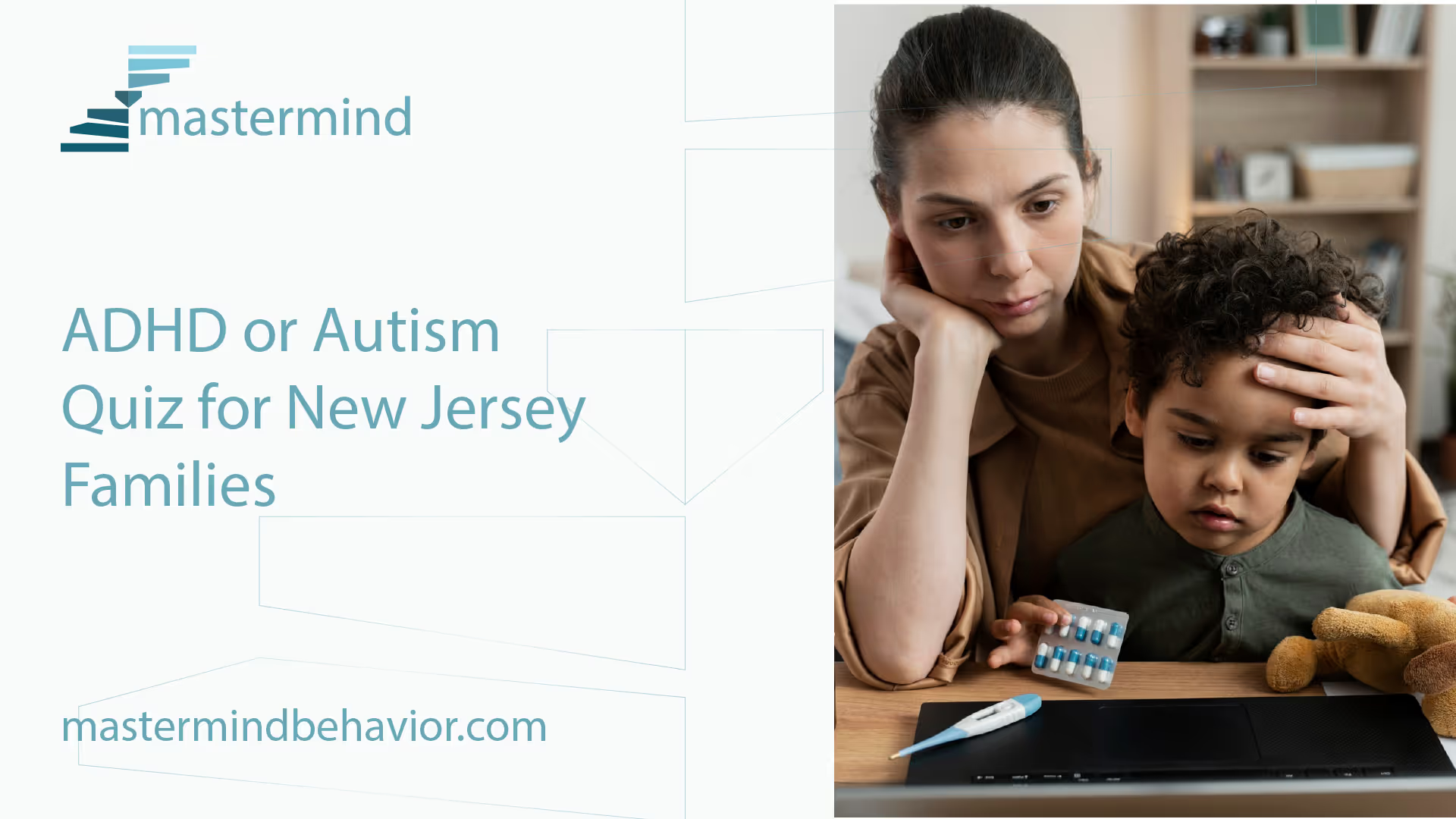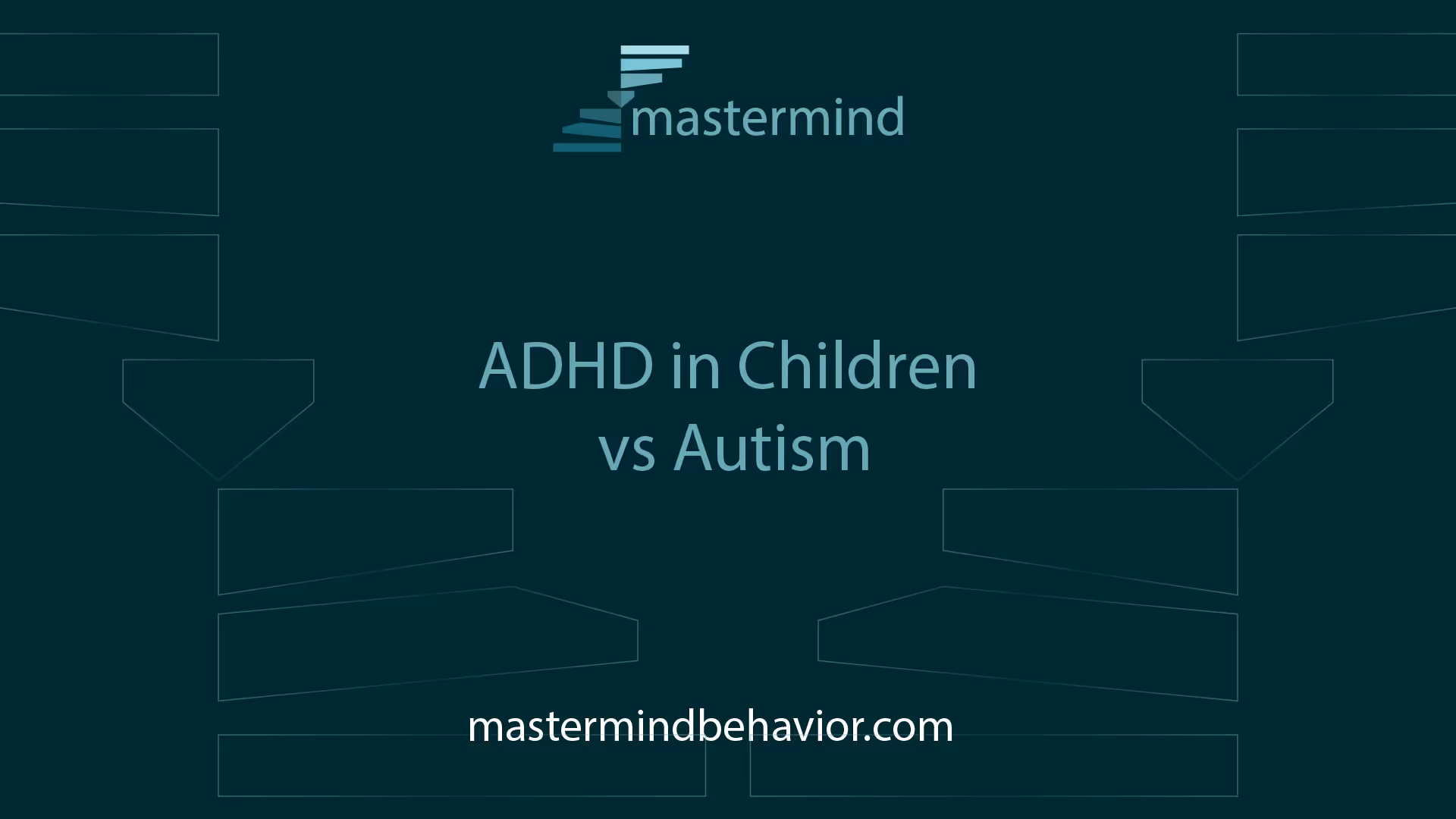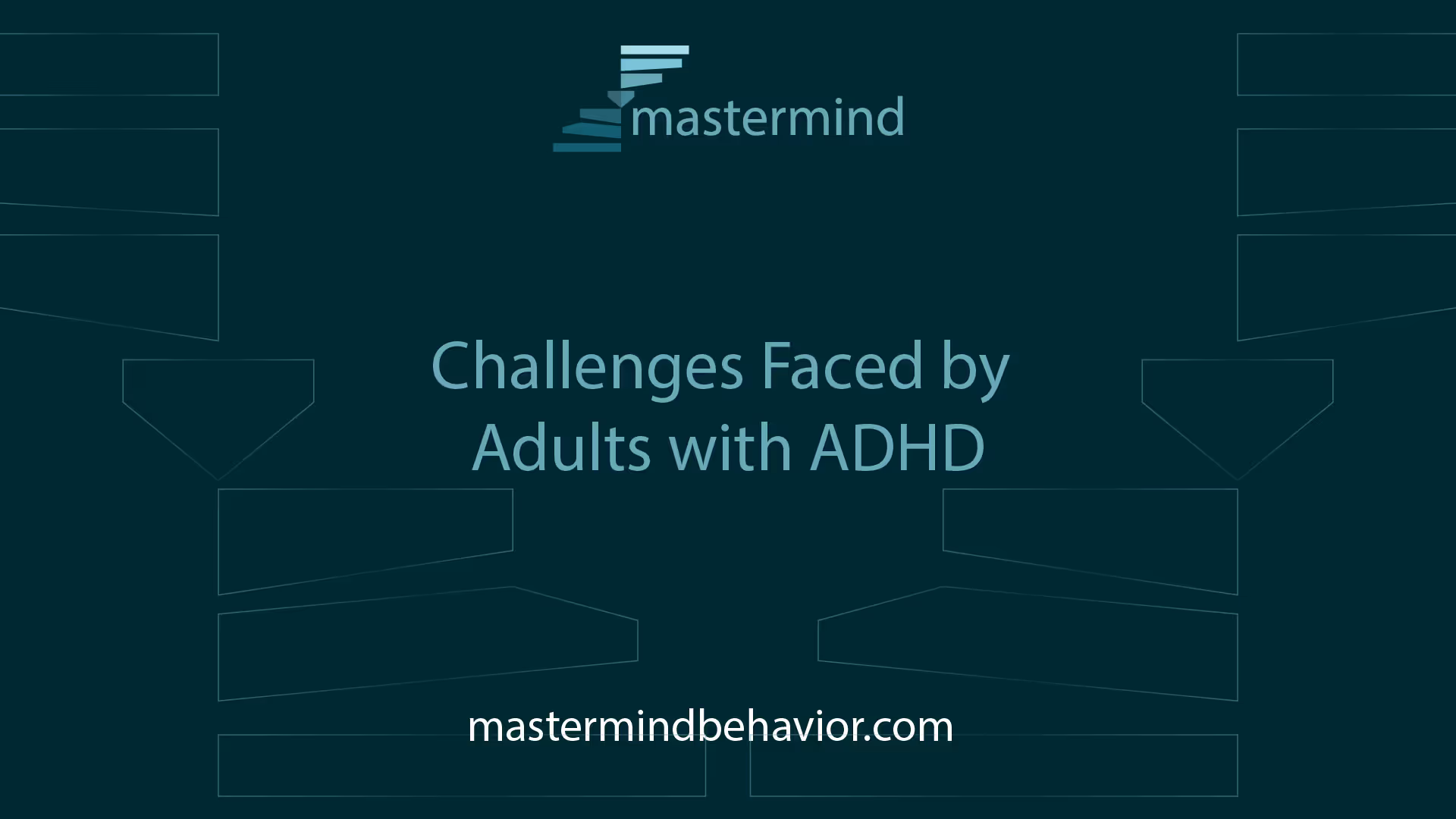ADHD or Autism Quiz for New Jersey Families

Understanding ADHD

ADHD, or Attention-Deficit/Hyperactivity Disorder, is a neurodevelopmental condition that affects both children and adults. It is characterized by difficulties with attention, impulsivity, and hyperactivity. Understanding the symptoms and characteristics of ADHD is essential in identifying and managing the condition.
ADHD Symptoms and Characteristics
People with ADHD have brain differences that affect their attention, making them more easily distracted than those without ADHD. They often struggle with staying organized, staying focused on tasks, and completing what they start [1]. The symptoms of ADHD can vary from person to person and can be categorized into three main types or presentations:
- Inattentive Presentation: Individuals with this presentation often have difficulty paying attention to details, become easily distracted, and struggle to follow instructions or finish tasks. They may appear forgetful and have trouble organizing their thoughts and belongings.
- Hyperactive-Impulsive Presentation: This presentation is characterized by excessive physical activity, restlessness, and difficulty staying still or seated. Individuals may frequently interrupt others, have difficulty waiting for their turn, and struggle with impulse control.
- Combined Presentation: This presentation combines symptoms of both inattention and hyperactivity/impulsivity. Individuals exhibit a range of symptoms from both presentations and often experience the most significant challenges.
It is important to note that the presentation of ADHD can change over time as symptoms evolve. To learn more about the specific symptoms associated with ADHD, refer to our article on autism vs ADHD symptoms.
By recognizing the symptoms and characteristics of ADHD, individuals and their families can seek appropriate support and interventions to manage the challenges associated with the condition. Diagnosis plays a crucial role in understanding and addressing ADHD effectively, which we will explore in the next section.
Types of ADHD Presentations
ADHD is categorized into three types, also known as presentations, based on the types of symptoms an individual displays. These presentations are:
- Inattentive Presentation: This type primarily involves difficulties with attention and focus. Individuals with this presentation may struggle to sustain attention, become easily distracted, and have trouble following instructions or completing tasks.
- Hyperactive-Impulsive Presentation: This type primarily involves hyperactivity and impulsivity. Individuals with this presentation may have trouble staying still, constantly fidget, and act impulsively without considering the consequences.
- Combined Presentation: This type includes symptoms from both the inattentive and hyperactive-impulsive presentations. Individuals with the combined presentation experience challenges with attention, hyperactivity, and impulsivity.
It is important to note that the presentation of ADHD can change over time as symptoms change. Understanding the specific presentation can help in tailoring interventions and support for individuals with ADHD. To learn more about the diagnostic process for ADHD, refer to our article on autism vs ADHD diagnosis.
By understanding the symptoms and types of presentations associated with ADHD, individuals and their families can gain insight into the challenges they may face and seek appropriate resources and interventions to support their needs.
Diagnosing ADHD
When it comes to diagnosing ADHD, there is no single test that can definitively determine its presence. The process of diagnosing ADHD involves several steps and considerations. It is important to differentiate ADHD from other conditions that may have similar symptoms [2]. Let's explore the process of diagnosing ADHD and how it is differentiated from other conditions.
Process of Diagnosing ADHD
Diagnosing ADHD typically involves a comprehensive evaluation conducted by mental health providers or primary care providers. The diagnostic process consists of various components, including:
- Clinical Assessment: A healthcare professional will conduct a clinical assessment that involves gathering information about the individual's symptoms, medical history, family history, and psychosocial functioning. This assessment may include interviews with the individual, parents, teachers, and other caregivers.
- Behavioral and Symptom Rating Scales: To aid in the diagnostic process, behavioral and symptom rating scales are often used. These scales provide standardized questionnaires that assess the presence and severity of ADHD symptoms. They are typically completed by the individual, parents, teachers, and other caregivers.
- Observation and Feedback: Observations of the individual's behavior in different settings, such as home and school, can provide valuable insights. Feedback from parents, teachers, and other caregivers is also essential to gather information about the individual's behavior and functioning across various contexts.
- Rule Out Other Conditions: It is crucial to rule out other conditions that may mimic ADHD symptoms. Conditions such as sleep disorders, anxiety, depression, and certain learning disabilities can have symptoms similar to ADHD. A thorough evaluation helps differentiate ADHD from these conditions.
Differentiating ADHD from Other Conditions
Differentiating ADHD from other conditions requires careful consideration and evaluation. Some conditions that may have similar symptoms to ADHD include learning disorders, mood disorders, anxiety disorders, substance use disorders, head injuries, thyroid conditions, and the use of certain medications [3]. Additionally, ADHD may coexist with other mental health conditions, such as oppositional defiant disorder, conduct disorder, anxiety disorders, and learning disorders.
The diagnostic process involves a thorough assessment of the individual's symptoms, history, and functioning. By considering the duration, frequency, and severity of symptoms, healthcare professionals can differentiate ADHD from other conditions and determine an accurate diagnosis. It is important to consult with a healthcare professional experienced in diagnosing ADHD to ensure an accurate evaluation.
If you suspect that you or your child may have ADHD or if you are seeking an evaluation, it is important to reach out to a healthcare professional who specializes in ADHD diagnosis. They will guide you through the process and provide appropriate support and recommendations.
Understanding the process of diagnosing ADHD and differentiating it from other conditions is crucial for individuals seeking clarity and appropriate intervention. By obtaining a comprehensive evaluation, individuals can receive the necessary support and treatment tailored to their specific needs.
ADHD in Children vs Autism

When it comes to differentiating between ADHD and autism in children, it's important to understand the contrasting symptoms and overlapping behaviors associated with each condition.
Contrasting Symptoms in Children
Children with ADHD and autism often exhibit different patterns of behavior that can help distinguish between the two conditions. While these symptoms may vary from child to child, there are some general differences to consider:
- Attention and Focus: Children with ADHD typically struggle with maintaining attention and focus, especially on tasks they find uninteresting. On the other hand, children with autism may have difficulty with attention due to heightened sensitivity to stimuli or difficulty understanding social cues.
- Social Interaction: Children with autism often have challenges with social awareness and may find it difficult to express their thoughts and feelings verbally. In contrast, children with ADHD may talk excessively, interrupt conversations, and experience difficulty making eye contact [4].
- Routines and Repetition: Children with autism typically have a strong preference for routines and repetition, finding comfort in predictability. In contrast, children with ADHD may not have the same preference for routine or repetition, even if it may benefit their focus [4].
Overlapping Behaviors
While there are distinct differences in symptoms, it's important to note that there can also be overlapping behaviors between ADHD and autism. Some behaviors may be present in both conditions, making it challenging to differentiate solely based on these shared characteristics. For example:
- Hyperactivity and Impulsivity: Both ADHD and autism can involve hyperactive and impulsive behaviors. Children diagnosed with both conditions may exhibit a combined type of ADHD, which includes hyperactive and impulsive symptoms alongside difficulties with attention [4].
- Executive Functioning: Difficulties with executive functioning, such as organization, time management, and planning, can be present in both ADHD and autism. These challenges may impact a child's daily functioning and academic performance [5].
Understanding the differences and similarities between ADHD and autism is crucial for providing the right support and intervention for children. Early diagnosis can lead to early intervention, significantly improving a child's development and quality of life. If you're seeking further information on autism and ADHD, our article on autism spectrum disorder vs ADHD provides a comprehensive comparison of the two conditions.
Evaluating ADHD and Autism
When it comes to differentiating between ADHD and autism, it is important to undergo proper evaluation and assessment. This section explores the assessments available for ADHD and autism and emphasizes the importance of professional evaluation.
Assessments for ADHD and Autism
Diagnosing ADHD or autism is not a simple task and there is no single test that can definitively determine the presence of either condition. The process of diagnosing ADHD involves several steps and relies on the observation of behaviors over time, as well as gathering feedback from parents, teachers, and other caregivers. Additionally, other conditions such as sleep disorders, anxiety, depression, and certain learning disabilities can have symptoms similar to ADHD, making accurate assessment crucial [2].
For autism, the diagnosis process may start with a parent answering a questionnaire about the child's behaviors from a young age. These assessments help identify patterns of behavior and provide valuable information for professionals in making an accurate diagnosis. Early intervention and support are key to improving outcomes for individuals with autism and ADHD [4].
It's worth noting that a child can have both ADHD and autism, and in some cases, the symptoms may overlap. Some children diagnosed with both conditions may exhibit a combined type of ADHD, which includes both hyperactive, impulsive symptoms and trouble paying attention [4]. Understanding the differences between ADHD and autism is crucial for providing tailored support and intervention.
To assess the presence of autism or ADHD, it is recommended to seek professional evaluation from healthcare providers, psychologists, or specialists experienced in diagnosing and treating neurodevelopmental disorders. They will utilize various assessment tools and techniques to gather comprehensive information about the individual's behavior, development, and functioning. These evaluations help provide a clearer understanding of the individual's strengths, challenges, and any potential underlying conditions.
Importance of Professional Evaluation
Professional evaluation is essential in distinguishing between ADHD and autism. While online quizzes and self-assessments may provide some insights, they cannot replace the expertise and thoroughness of a professional evaluation. Qualified professionals will consider a range of factors, including behavioral observations, medical history, developmental milestones, and input from parents, teachers, and other caregivers.
Early diagnosis and intervention play a crucial role in supporting individuals with ADHD or autism. Through professional evaluation, individuals and their families can gain a better understanding of their strengths and challenges, allowing for targeted interventions and support services to be implemented. The right diagnosis and appropriate interventions can significantly improve a child's development, learning, and overall quality of life.
If you suspect that you or your child may have ADHD or autism, it is recommended to consult with healthcare professionals who specialize in neurodevelopmental disorders. They can guide you through the assessment process and provide the necessary support and resources. Remember, an accurate diagnosis is the first step towards accessing the appropriate interventions and services needed for individuals with ADHD or autism.
Managing ADHD in Adults
Adults with ADHD often face unique challenges that can impact various aspects of their lives. Understanding these challenges and implementing effective strategies can greatly improve daily functioning and quality of life.
Challenges Faced by Adults with ADHD

ADHD can present challenges for adults across different areas of life. Some common difficulties experienced by adults with ADHD include:
- Impulse control: Adults with ADHD may struggle with impulse control, leading to impulsive actions or decisions that can have negative consequences.
- Inattention and distractibility: Difficulty maintaining focus and being easily distracted can make it challenging to complete tasks or follow through on responsibilities.
- Organization and time management: Adults with ADHD may struggle with organizing tasks, managing their time effectively, and meeting deadlines.
- Procrastination: Procrastination is a common challenge for adults with ADHD, leading to last-minute rushes and increased stress levels.
- Relationship difficulties: ADHD symptoms can impact personal and professional relationships, as adults with ADHD may struggle with listening, communicating effectively, or maintaining consistent attention during conversations.
- Financial management: Money management can be a challenge for adults with ADHD, leading to issues such as overspending, missed bill payments, and disorganization in financial matters.
It's important to note that individuals with ADHD are not unmotivated or unintelligent. ADHD is a disorder that interferes with normal functioning, and individuals often have to find smart ways to compensate for their challenges.
Strategies for Coping with ADHD
While there is no cure for ADHD, there are strategies that adults can employ to effectively manage their symptoms and reduce the problems associated with ADHD. Here are some strategies that can be helpful:
- Break tasks into smaller steps: Breaking down large projects or tasks into smaller, more manageable steps can make them less overwhelming and increase the likelihood of completion.
- Prioritize tasks: Prioritizing tasks based on importance and deadlines can help individuals with ADHD focus on what needs to be accomplished first.
- Set reminders and use organizational tools: Utilizing technology and organizational tools, such as calendars, reminders, and to-do lists, can assist in managing time, appointments, and important tasks.
- Create a structured routine: Establishing a consistent daily routine can provide a sense of structure and help with time management and organization.
- Practice self-care: Engaging in regular exercise, getting enough sleep, and maintaining a healthy diet can positively impact overall well-being and help manage ADHD symptoms.
- Seek support: Whether it's through support groups, therapy, or seeking guidance from healthcare professionals, reaching out for support can provide valuable strategies and coping mechanisms.
- Consider medication and therapy: Medication and therapy, such as cognitive-behavioral therapy (CBT), can be effective in managing ADHD symptoms. Consulting with a healthcare professional can help determine the best treatment options for individual needs.
Remember, managing symptoms of ADHD can become second nature with the use of helpful strategies. It's important to be patient with oneself and understand that progress takes time [6]. By implementing these strategies and seeking appropriate support, adults with ADHD can navigate their daily lives more effectively and thrive.
Treatment Options for ADHD
When it comes to managing ADHD, there are various treatment options available. These options aim to alleviate symptoms, improve daily functioning, and enhance overall quality of life for individuals with ADHD. Treatment for ADHD often involves a combination of medication and therapy.
Medication and Therapy for ADHD
Medication is a common approach to treating ADHD. Psychostimulants, such as amphetamines and methylphenidate, are typically the first-line pharmacological treatments for managing ADHD. These medications work by increasing the levels of certain brain chemicals responsible for regulating attention and impulse control. Other FDA-approved options include alpha agonists like clonidine and guanfacine, as well as atomoxetine, a selective norepinephrine reuptake inhibitor [3].
In addition to medication, therapy plays a crucial role in the treatment of ADHD. Behavioral therapy, such as cognitive-behavioral therapy (CBT), is often recommended. CBT helps individuals with ADHD develop strategies to improve time management, organizational skills, and impulse control. It also addresses emotional regulation and social skills, which can be affected by ADHD symptoms.
For children with ADHD, parent training programs may be beneficial. These programs provide parents with strategies to effectively manage their child's behavior, create structure and routines, and improve communication within the family.
Multifaceted Approaches to ADHD Treatment
In addition to medication and therapy, a multifaceted approach to ADHD treatment may include several other strategies:
- Education and Psychoeducation: Learning about ADHD and its symptoms can help individuals and their families better understand the condition and develop appropriate coping mechanisms. Psychoeducation programs provide information, support, and guidance to individuals with ADHD and their families.
- Environmental Modifications: Making changes to the environment can help individuals with ADHD manage their symptoms more effectively. This may involve creating a structured routine, minimizing distractions, and providing visual cues or reminders.
- Supportive Services: Additional supportive services, such as occupational therapy or speech therapy, may be beneficial for individuals with ADHD who have specific challenges related to sensory processing, motor skills, or communication.
- Lifestyle Modifications: Adopting healthy lifestyle habits can have a positive impact on symptoms of ADHD. Regular exercise, a balanced diet, adequate sleep, and stress management techniques can all contribute to overall well-being and help manage ADHD symptoms.
It's important to note that treatment for ADHD should be tailored to each individual's specific needs. A comprehensive evaluation by a healthcare professional is essential to determine the most appropriate treatment plan. For adults with ADHD, treatment may vary depending on their unique challenges and circumstances. To learn more about ADHD in adults, consult with a qualified healthcare provider.
Remember, managing ADHD is an ongoing process that requires patience, perseverance, and a multidimensional approach. With the right combination of medication, therapy, and lifestyle adjustments, individuals with ADHD can effectively manage their symptoms and lead fulfilling lives.
References
[1]: https://kidshealth.org/en/teens/adhd-tips.html
[2]: https://www.cdc.gov/adhd/signs-symptoms/index.html
[3]: https://www.psychiatry.org/patients-families/adhd/what-is-adhd
[4]: https://www.webmd.com/add-adhd/childhood-adhd/adhd-or-autism
[5]: https://getgoally.com/blog/do-i-have-autism-or-adhd-quiz/
[6]: https://www.helpguide.org/articles/add-adhd/managing-adult-adhd-attention-deficit-disorder.htm
Recent articles

Understanding Perseverative Behaviors and How to Redirect Them in Autism
Deciphering The Loop: Insights into Perseveration in Autism

The Importance of Routine and Consistency in ABA Therapy
Building a Stable Foundation for Success

Using Visual Supports to Enhance ABA Therapy Success
Empowering Communication and Learning in ABA with Visual Supports

The Connection Between Behavioral Therapy and Autism Education
Harnessing Behavioral Interventions to Transform Autism Learning

Understanding Functional Behavior Assessments and Their Role in ABA Therapy
The Science Behind Behavior Change in Autism Support

How Caregiver Training Supports ABA Therapy Goals at Home
Empowering Families for Better Outcomes in Autism Support


